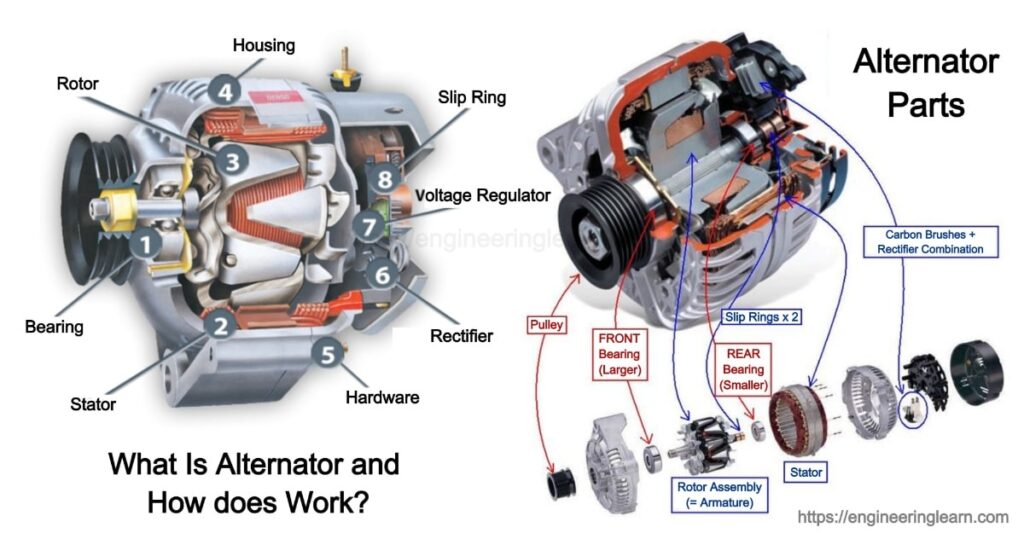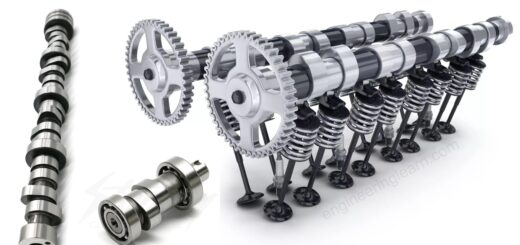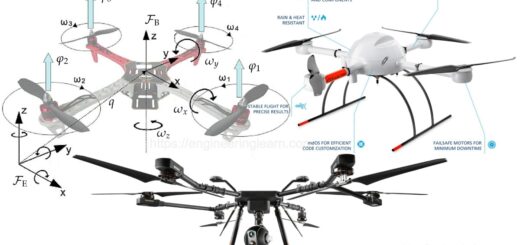What Is Alternator and How does Works?

What Is an Alternator?
What Is Alternator and How does Works? :- An alternator refers to as an electric generator which is used to convert the mechanical energy into electrical energy. The energy which is converted is only in the form of an alternating current. In order to make it economical and simple, most of the alternators use a rotating magnetic field accompanied by a stationary armature. A linear alternator or a rotating armature can also be used with a stationary magnetic field depending upon the site requirement. For instance, an AC electrical generator can also be termed as an alternator as most of the time this term refers to a small rotating machine which is driven by an automotive and other internal combustion engine.
People have the misconception that the battery of the vehicle is responsible for conducting various actions but actually, it is the alternator of the car which produces the majority of the vehicle’s electricity. The battery is just installed to start the vehicle and provide it power whenever the engine is not running.An alternator is an important component of a charging system of any vehicle and so it is helpful in understanding its operation in case your vehicle is not starting.
By know it is clearly known that an alternator is a type of generator which is designed with an aim to distribute electricity to the vehicle and recharge the battery. Leaving some hybrid models, all the vehicles undergo a standard internal combustion engine which have an alternator. An alternator is usually mounted on the front of the engine which has a belt running around it.
Components of Alternator
The main components and functions of an alternator are as follows:
1. Rotor and Stator
These are the components of an alternator which are responsible for producing electricity. The rotor is a cylindrical piece which is surrounded by magnets and spins inside the stator, which holds a fixed set of conductive copper wiring. The electricity is created by the movement of magnets over the wiring.
2. Voltage Regulator
The voltage regulator reviews the power which an alternator produces. It also monitors the level of voltage which refers to as its output which the battery delivers to the rest of the vehicle.
3. Diode Rectifier
The diode rectifier is used to convert the voltage from an alternator into a form which can be used by the battery to recharge.
4. Cooling Fan
Alternators emit a lot of heat which needs to be cooled at a certain time gap in order to maintain efficient working of the machine. These fans are built with the vents and aluminum casing to release the heat well. These are also equipped with rotating fans for higher cooling. Latest alternator models have internal cooling fans, whereas the previous versions had external fan blades.
How does Alternator works?
An alternator is used in the vehicles which helps to recharge the battery. For this the alternator needs to convert mechanical energy into electrical energy.
How The Alternator Produces Electricity?
Production of electricity starts with the engine of the vehicle. Mostly the alternators are driven via crankshaft of the engine through a serpentine belt, however the older vehicles may have a separate pulley moving from the crankshaft to the alternator. The movement of the belt or its mechanical energy is responsible for spinning the rotor of the alternator at a very high speed within the stator.
Once the rotor spins the electricity is produced. The magnets which are surrounded by the rotor are purposely placed in order to pass over the copper wiring in the stator and create a magnetic field. The magnetic field which is created produces a voltage which is captured by the stator. This power reaches the voltage regulator that disperses the electricity to the vehicle and manages the amount of voltage received by the battery.
How does the Alternator Charge the Battery?
In order to use the power being generated by the battery coming from the alternator, it needs to be converted into a proper format which the battery can accept. This is done as the electricity can flow in various currents, or directions. You will be delighted to know that the batteries of the car operate only on one way DC current electricity as the direct current helps in charging the battery whereas if the alternate current is used the battery would charge and discharge simultaneously leading to not let the battery get charged.
Working Principle of Alternator
The working principle of an alternator is same as that of an electromagnetic induction and according to this law, for the production of electricity there is a need of a conductor, a magnetic field and mechanical energy. Every machine which rotates, reproduces alternating current only. To learn the working principle of an alternator, it is suggested to consider two opposite magnetic poles north and south, and the flux which is traveling between these two magnetic poles. The position of the coil is set in such a manner that the coil becomes parallel to the flux, which results in no flux cut and thus no current induced.
Applications of Alternator
The applications of an alternator are follows:
- Use in automobiles.
- Use in electrical power generating plants.
- Used in marine applications.
- Use in diesel electric, multiple units.
- Used for Radio frequency transmission.
Advantages of Alternator
The advantages of an alternator are as follows:
- Cost Effective
- Light in weight
- Low maintenance
- Simple to Construct
- Robust
- Highly compactable
Disadvantages of Alternator
The disadvantages of an alternator are follows:
- The Alternators necessarily need a transformer to work properly.
- Alternators can get heated if the current flow is high.
Types of Alternator
There are five different types of alternators which are most commonly known and are as follows:
- Automotive alternators: Mostly used in modern automobiles.
- Diesel or electric locomotive alternators: Commonly used in diesel electric multiple units.
- Marine alternators which is used in marine applications.
- Alternators like brushless are mostly used in electrical power generation plants as the main source of power.
- Radio alternators are those which are used for low band radio frequency transmission.
( What Is Alternator and How does Works? )













